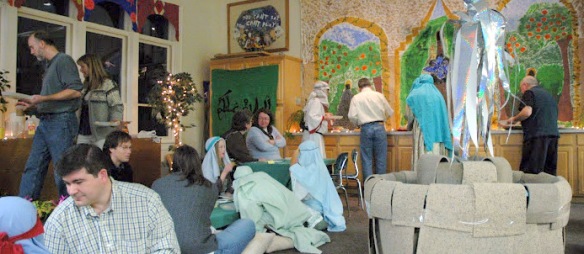The Touchstone Common Room has been transformed into a palace courtyard, with twinkling lights, a mylar fountain, and carefully painted scenery.
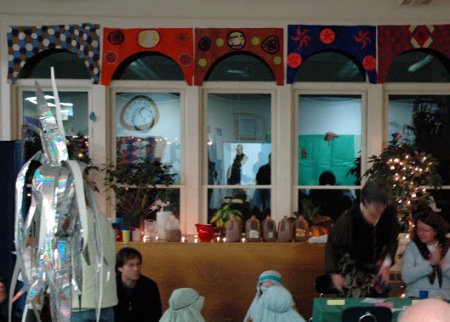 Wearing the loose, richly decorated clothing of long-ago centuries and far away places, kids stand tall and proud, representing people whose achievements still shape our lives, even though their names have been forgotten.
Wearing the loose, richly decorated clothing of long-ago centuries and far away places, kids stand tall and proud, representing people whose achievements still shape our lives, even though their names have been forgotten. 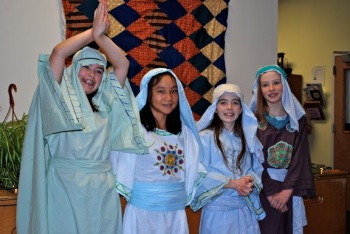 After the presentations, gathering around low tables with their families, kids try foods they wouldn’t usually touch with ten foot poles–because in this case, after all, they helped with the cooking.
After the presentations, gathering around low tables with their families, kids try foods they wouldn’t usually touch with ten foot poles–because in this case, after all, they helped with the cooking.
It’s all magic, magic we made together.
 In designing our version of the Alhambra Banquet, I found both inspiration and practical help in resources assembled by Audrey Shabbas at AWAIR, Arab World and Islamic Resources. As part of a workshop I attended at Clark University in Worcester, Massachusetts, Shabbas described a new approach to the study of medieval Europe, which would include the vital role of Arab Spain, often omitted. To engage students with this hidden history, she had conceived of a banquet in the Alhambra Palace in Granada.
In designing our version of the Alhambra Banquet, I found both inspiration and practical help in resources assembled by Audrey Shabbas at AWAIR, Arab World and Islamic Resources. As part of a workshop I attended at Clark University in Worcester, Massachusetts, Shabbas described a new approach to the study of medieval Europe, which would include the vital role of Arab Spain, often omitted. To engage students with this hidden history, she had conceived of a banquet in the Alhambra Palace in Granada.
I’m going to quote from a letter I wrote to parents:
[From the Alhambra] we look back to the 700 years of Muslim Spain, in which Christians, Jews and Muslims lived together in relative peace and prosperity; and in which all three religions co-existed comfortably with advances in science, technology, and culture that were largely unknown in the rest of Europe during the same period.
We look out to the world of the Mediterranean, where trade and the common language of Arabic created connections between many cultures; and where the Arab enthusiasm for paper, an invention brought from China, resulted in an explosion of publishing and translating and an unprecedented exchange of ideas.
Shabbas asked classes like ours to imagine travel through space–the entire Islamic world of the time, around much of the Mediterranean, but also beyond, including the rest of Europe. We also imagined travel through time. Students represented artists, architects, rulers, Sufi mystics, rabbis, Christian nuns, Muslim philosophers, librarians, book collectors, poets, physicians, mathematicians, and astronomers, from across seven centuries of the medieval world.
In our imaginations, in a grand triumph of serious playfulness, all these ancient people came together for a glittering, century-transcending, multicultural, multi-generational dinner party.
When I set out to design the way the AWAIR curriculum would unfold for us, I found inspiration also in the creativity and intellectual ambition of Touchstone students, and in the generosity of their parents’ involvement in the classroom. I knew that we could handle these rich, challenging, unfamiliar worlds and concepts in hands-on ways that would make them real for us.
First, we set our sights high. Literally. Up above the whiteboard at the front of the classroom, I posted Essential Questions for this study:
-
If we could hold an imaginary banquet in about 1400 in Spain, and invite people from past centuries and the whole world known at that time, who could come? What could they talk about?
-
How did life in Al Andalus look and feel and taste?
-
How are we still influenced by the religions and cultures represented at this banquet?
-
What can Al Andalus teach us about the ingredients of successful multicultural societies?
In the light of those questions, we got down to work. During the four or five weeks leading up to the banquet, each student became involved in five different efforts:
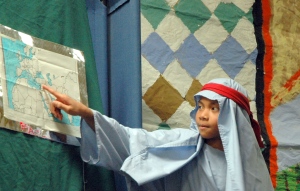 #1 As a whole group, we learned about the background history and geography. We arranged big file cards into time lines by rearranging our own bodies in a line. We created a giant map of the Mediterranean world in the gym, each person representing an important city. I vividly remember Kate Keller describing the evolution of the mathematical idea of zero, and how that idea found its way from India to northern Europe, by way of Arab Spain. In their classes, our Spanish teachers helped us think about the history of Spain as part of a larger Mediterranean history, and as a hinge between worlds. Taking it slowly and carefully, I found ways to explore Ibn Rushd’s sense of the relationship between revelation and reason–and marveled at the ideas with which these young students could engage.
#1 As a whole group, we learned about the background history and geography. We arranged big file cards into time lines by rearranging our own bodies in a line. We created a giant map of the Mediterranean world in the gym, each person representing an important city. I vividly remember Kate Keller describing the evolution of the mathematical idea of zero, and how that idea found its way from India to northern Europe, by way of Arab Spain. In their classes, our Spanish teachers helped us think about the history of Spain as part of a larger Mediterranean history, and as a hinge between worlds. Taking it slowly and carefully, I found ways to explore Ibn Rushd’s sense of the relationship between revelation and reason–and marveled at the ideas with which these young students could engage.
 #2 Through a process of choosing from among various professions and roles, each student took on a historical figure to represent. (Adults sometimes filled in gaps. I’m not sure who was being represented by Don Grace in the year of most of these photographs, but the kids did a great job on his clothing!)
#2 Through a process of choosing from among various professions and roles, each student took on a historical figure to represent. (Adults sometimes filled in gaps. I’m not sure who was being represented by Don Grace in the year of most of these photographs, but the kids did a great job on his clothing!)
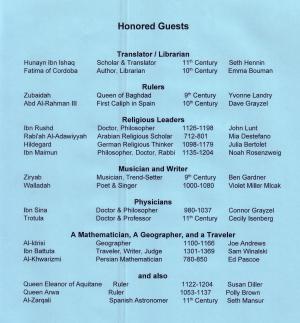 Working hard to understand challenging sources, students found it exhilarating to take on the identities of people such as Ibn Sinna, known in the West as Avicenna, who brought scientific methods to the study of medicine and healing; or Zubaidah, a queen of Baghdad who set new standards for public works, particularly a series of wells, reservoirs and artificial pools that provided water for Muslim pilgrims along the route from Baghdad to Mecca. It’s driving me crazy not to describe all the people we called back to life. But you can click to enlarge this fairly representative list from 2011.
Working hard to understand challenging sources, students found it exhilarating to take on the identities of people such as Ibn Sinna, known in the West as Avicenna, who brought scientific methods to the study of medicine and healing; or Zubaidah, a queen of Baghdad who set new standards for public works, particularly a series of wells, reservoirs and artificial pools that provided water for Muslim pilgrims along the route from Baghdad to Mecca. It’s driving me crazy not to describe all the people we called back to life. But you can click to enlarge this fairly representative list from 2011.
 If a student represented someone well-documented in resources available to us, he or she had to set priorities for what would be included in a two minute presentation. For figures about whom we could find very little, even making careful use of resources on the internet, students branched out to include more information about the person’s areas of work or interest, using resources that would explain monastic life, or Islamic architecture, or the history of mathematics.
If a student represented someone well-documented in resources available to us, he or she had to set priorities for what would be included in a two minute presentation. For figures about whom we could find very little, even making careful use of resources on the internet, students branched out to include more information about the person’s areas of work or interest, using resources that would explain monastic life, or Islamic architecture, or the history of mathematics.
Each student checked in with one or two partners, with whom they could share and compare, and stand together in front of the banquet’s assembled audience.
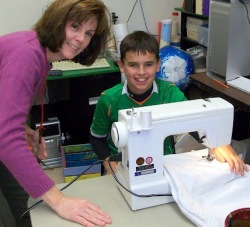 # 3 To help students enter the spirit of these representations, parents worked with them to create special clothing, decorated with magic marker “embroidery” using the motifs and styles of medieval Islamic design.
# 3 To help students enter the spirit of these representations, parents worked with them to create special clothing, decorated with magic marker “embroidery” using the motifs and styles of medieval Islamic design.
#4 Students also prepared scenery and decorations for the Common Room. In our own microcosm of cultural evolution and preservation, we saved some of these murals and columns and window-top decorations from year to year, so any particular class knew that aspects of their work would last, and be built on by future classes.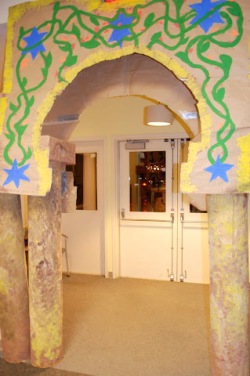 #5 Finally, what’s a banquet without a feast? Some typical foods of Arab Spain could be prepared ahead by the students during projects time, and frozen in home freezers. Other things–vegetarian kufti, chickens roasted with dried fruit, flan–were cooked at home and brought in by parents the night of the banquet–along with pillows to make it easier for all of us to sit on the floor at low tables, and potted plants to help us simulate the lush gardens of the Alhambra.
#5 Finally, what’s a banquet without a feast? Some typical foods of Arab Spain could be prepared ahead by the students during projects time, and frozen in home freezers. Other things–vegetarian kufti, chickens roasted with dried fruit, flan–were cooked at home and brought in by parents the night of the banquet–along with pillows to make it easier for all of us to sit on the floor at low tables, and potted plants to help us simulate the lush gardens of the Alhambra.
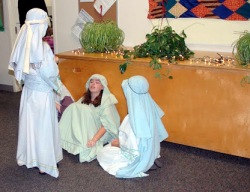
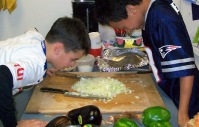 Through the weeks before the banquet, kids rotated through projects time groups working with wonderful parent helpers along with teachers and aides, to create clothing, scenery, and food. They read background text related to the clothing, food, and design of medieval Arab Spain. They practiced taking notes, shared what they had understood–and then chopped up tremendous quantities of onion or garlic, or crawled all over the floor collaborating on complex designs.
Through the weeks before the banquet, kids rotated through projects time groups working with wonderful parent helpers along with teachers and aides, to create clothing, scenery, and food. They read background text related to the clothing, food, and design of medieval Arab Spain. They practiced taking notes, shared what they had understood–and then chopped up tremendous quantities of onion or garlic, or crawled all over the floor collaborating on complex designs.
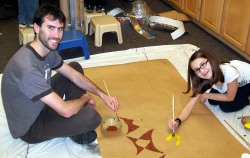 Throughout this entire process, and by the end of the banquet, all the adults involved were captivated and stunned–by the students’ hard work and accomplishments, and by the content they worked to share with us.
Throughout this entire process, and by the end of the banquet, all the adults involved were captivated and stunned–by the students’ hard work and accomplishments, and by the content they worked to share with us.
What did students get out of it all? I wanted to document this with excerpts from their own reflective writing as we went along, and afterwards–but I’m writing out of a blizzard zone, and can’t find those right now. So I have to try to summarize.
Because these students were so young, almost everything we learned in this study was new. Thinking back, I see faces scrunched up with the effort to grasp strangeness, and glowing with the satisfaction of making sense. Conceptually, they reached far, reached deep, and felt the strength of that reaching.
They also shared my satisfaction in their nitty-gritty skills growth: in note-taking, in handling unfamiliar words and other aspects of challenging texts, in interpreting maps and timelines and other charts, in oral presentation, in giving each other useful feedback.
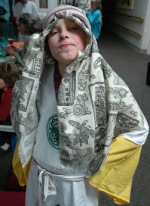 Above all, students loved the way most of the learning we shared at the banquet was new to their families–so that their sharing had real focus and purpose. Students felt important, and powerful. I have memories of kids putting on the special clothing they had made (from recycled bed sheets transformed with love and patience)–then straightening up with an amazing light in their eyes.
Above all, students loved the way most of the learning we shared at the banquet was new to their families–so that their sharing had real focus and purpose. Students felt important, and powerful. I have memories of kids putting on the special clothing they had made (from recycled bed sheets transformed with love and patience)–then straightening up with an amazing light in their eyes.
All of us remember with wonder the physical world of the banquet, so much a product of grand collective effort–but all of us, both students and adults, remember even more the passion in student presentations, the miracles of stepping up, the deeply personal pride.
And, of course, the wild exultation when they were done.
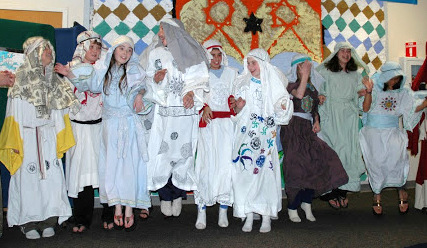 I’d be thrilled to hear from past Alhambra Banquet participants, or to help others create their own Alhambra Banquet experience. You can write one of the usual comments, for others to see, or send something directly to me using the contact form below.
I’d be thrilled to hear from past Alhambra Banquet participants, or to help others create their own Alhambra Banquet experience. You can write one of the usual comments, for others to see, or send something directly to me using the contact form below.

